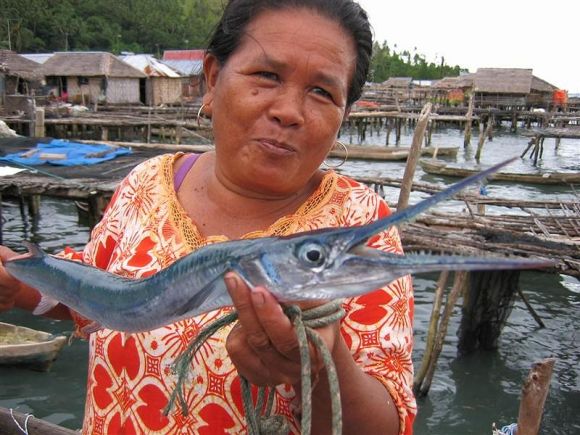In our new edition, Inside Indonesia explores different perspectives on tourism
Emma Baulch
Displaying a needlefish on Nain Island, Bunaken National Marine Park
|
The tourism industry is notorious for papering over cultural complexities in the interests of building an image of a place as attractive and desirable to tourists. Given this, it is apt that Inside Indonesia, a magazine with a mission to expose stereotypes and give voice to Indonesian people’s perspectives, dedicate an edition to the theme of tourism. In different ways, the articles in this edition disrupt the conventional tourist gaze.
The articles pursue two broad issues. Firstly, there are those which critically discuss prevailing tourism development models. In her piece detailing the tourism bureaucracy’s efforts to recover from the first and second Bali bombings, Dina Wipsar Andari draws attention to the intricacies of recovery, and some of the mistakes that have been made along the way. Graeme MacRae’s piece suggests that a recovery to pre-bomb style tourism may not be altogether desirable, given its negative consequences for local farmers. MacRae is optimistic, however, about the prospects for a symbiosis between expatriates and hotels on the one hand and a sustainable, organic agriculture on the other. Leila Sievanen’s article provides a different view of sustainable tourism. In her article, ‘sustainability’ is mere rhetoric and serves foreign capital much better than local livelihoods.
The second group of articles, those by Michele Ford, Laurens Bakker, Geoff Mulherin and Bart Barendregt, all highlight instances of Southeast Asians as tourists in Indonesia. In Barendregt’s article, rich Indonesian spa tourists embrace the romanticised ‘Orientalist’ depictions of Asia, and identify themselves with such images. In Michele Ford’s and Lenore Lyons' piece, lower class Singaporean men find comfort in the Riau islands, where they can live out their fantasies. In Laurens Bakker’s article, wealthy tourists from Kalimantan visit Bali, where Western tourists become the object of their gaze, while Geoff Mulherin describes a site of local tourism and nationalist edification in Makassar, South Sulawesi.
We did not set out to denounce tourism by favouring articles that expose the industry’s negative social, cultural and environmental impacts. Nor did we wish to champion particular kinds of tourism, or promote particular destinations. Overall, this edition gives voice to a cross-section of tourists’ perspectives, and of different perspectives about tourism. Each article has surprises in store for the readers. Together, they tell some of Indonesian tourism’s untold stories.
Emma Baulch (ebaulch@gmail.com) is a researcher based in Bali and a member of Inside Indonesia’s editorial team. Her new book, Making Scenes: Reggae, Punk, and Death Metal in 1990s Bali, is published by Duke University Press.
